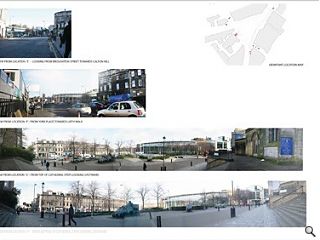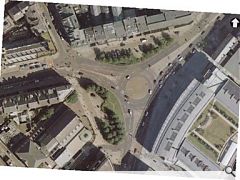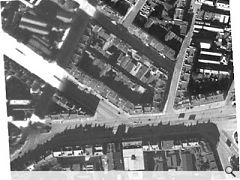Putting the place back in Picardy Place
4 Jun 2008
PICARDY PLACE: How do you make a roundabout a 'place' again?
Picardy Place is a depressingly triumphant example of the erosion of place through increase in traffic movement.
Often a place forms at the intersection of several streets, as it did with Picardy Place. Originally, this was a natural meeting place with a cathedral, markets and other kinds of activities. Yet as traffic increased, it was almost as though a fast flowing river began to wash away its banks, and as the torrent quickened and strengthened, the banks became progressively eroded. Pedestrian pavements narrowed and the road surface expanded to accommodate the flow of moving vehicles.
The proposed introduction of the Edinburgh tram route will increase that flow considerably. There will be a major tram stop at Picardy Place and the tram itself will compete for road space, so squeezing the movement of buses and cars. The Design Champion has been engaged with various architects, urbanists and transportation experts (Duncan Whatmore, Ian Alexander, Henry McKewon, Charlie Hussey, Charlie Sutherland, William Tunnell, David Anderson and John Dales) to rethink this junction. The Royal Assent drawings showed that 23 separate island hopping pedestrian crossings would be required once the new traffic plan was implemented. Our studies show that this could be reduced to ten.
Another significant urban erosion is the elimination of buildings that created a real sense of enclosure. Originally, as historical maps show, there was a group of buildings in the centre of Picardy Place, but these were demolished in the 1960s in order to construct the traffic roundabout. Further erosion will simply increase this effect, exposing the tram, the tram stop and a sea of tarmac, so that this key place would become a traffic dominated intersection on a scale more suited to suburbia.
However, with the right leadership and coordination there is potential for real urban design achievement. Adjacent is the very welcome re-planning of the St James’s Centre, Henderson Global, the developers, are showing that they understand the value of Place and how crucial it is for them. They have developed a long term strategic approach which is ensuring that their chosen masterplanners are producing place sensitive solutions. The Council has had a good engagement and reinforced the principles of placemaking sensitive development. This long forsaken area will be integrated back into the rest of the city centre and has the potential of acting as the link and gateway to the waterfront. The Design Champion team also proposed reinstating the islands in the middle of Picardy Place. This created a genuine interchange for the tram and bus stop and also connects with the re-developed St. James’s Centre, so strengthening and renewing the urban grain.
This is one of the most fascinating urban design challenges currently facing Edinburgh. Good urbanism and strong leadership is the key to making the best possible things happen, but there must also be integrated, joined-up thinking from all those involved - tram designers, retail masterplanners, road and traffic planners. Picardy Place is a pivotal node and if addressed correctly it has the potential for considerable architectural, urban and indeed also for commercial development opportunities, which could pay for much of the improvements.
|
|





